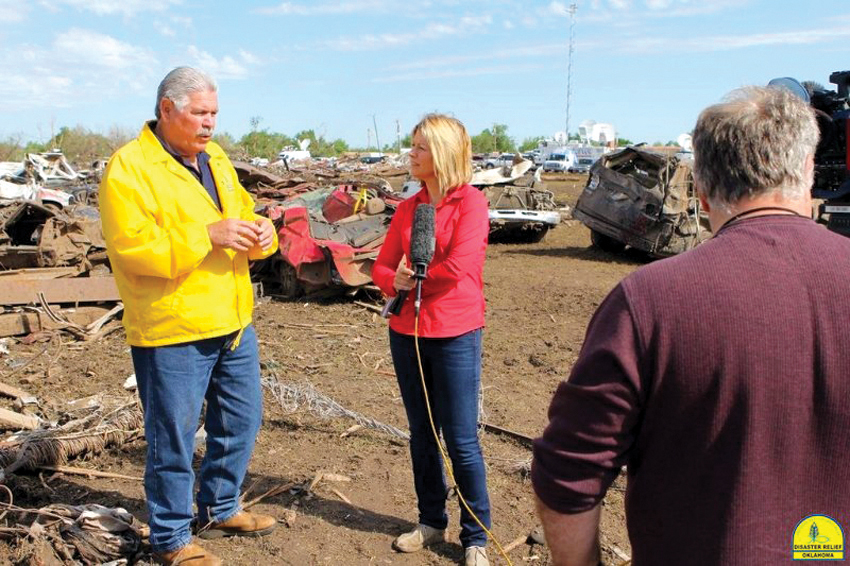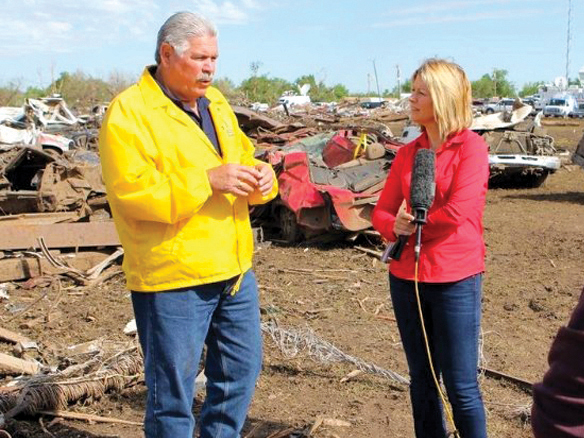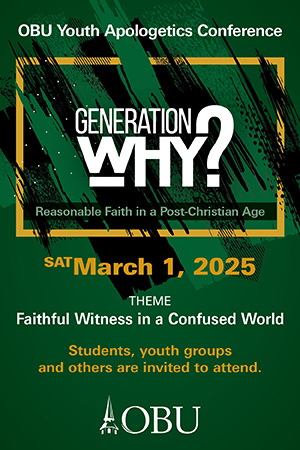 “. . . God had us in the palm of His hand. He hadn’t forsaken us because He never does, and He answered the prayers of His people around the world (that night).”
“. . . God had us in the palm of His hand. He hadn’t forsaken us because He never does, and He answered the prayers of His people around the world (that night).”
This heartfelt quote came from Baptist General Convention of Oklahoma (BGCO) Disaster Relief (DR) Director Sam Porter, as he recounted the day after the last tornado in a series of destructive storms that tore through Oklahoma.
On Sat., June 1, as Porter drove through the streets of south Oklahoma City all the way to Stanley Draper Lake, he was amazed to see no destruction in an area he knew should have been demolished.
That previous night, May 31, Porter was at home with his wife watching the weather as the world’s largest recorded tornado in history formed just east of El Reno. Its forecasted path was down I-40 straight into the heart of Oklahoma City. He remembers watching five vortexes form into one tornado logged at 2.6 miles long spinning at 295 mph. The infamous May 3, 1999 tornado was the world’s strongest tornado in history at one mile long spinning at 318 mph, so the May 31 storm was on track to do some major damage.
“I prayed, ‘God, you can’t let this happen,’ and I promise you, He answered that prayer, because the storm lifted right before (it got to) Yukon, and it never touched down again. . . God didn’t take the tornado away; He just picked it up, like a Father protecting His children.”
In 15 years as director, Porter has seen a lot. He’s been to or helped by sending a workforce to every major disaster in those years, including 9/11. Yet, despite all he’s witnessed, he still says, “Nothing is as destructive as an F5 (tornado), and I’ve seen every kind of disaster in the world.”
Southern Baptist Disaster Relief (SBDR) has been a major source of assistance for some time now as it is dubbed, according to Porter, the largest trained volunteer workforce in the world. Though the Red Cross and Salvation Army may be more widely known, it cannot be said about each of these organizations that the volunteer base is completely trained. However, it can be said about SBDR. The relationships between these organizations is strong, though, as SBDR has an agreement to prepare 85-90 percent of all hot meals served by either the Salvation Army or the Red Cross. The U.S. Federal Emergency Management Agency (FEMA) also works with SBDR to distribute contact information to any victim needing help.
Helping is exactly what Disaster Relief does. Within 20 minutes of the May 20 storm hitting Moore, Porter had made his way to Moore, First, and within three hours, the DR feeding unit was on site ready to prepare what would be more than 206,000 meals in the next 40 days.
Serving meals isn’t the only thing the organization does for victims. They also have equipment to move debris similar to what demolition companies use. The difference is that what a demolition company charges an individual for debris removal, anywhere from $4,000-$8,000, SBDR does the same for free. This is overwhelming when you consider SBDR cleared debris from more than 1,000 homes following the spring storms. SBDR was able to do $4 million worth of work at no charge to homeowners because of the generosity of donors.
Disaster Relief is completely funded by the Edna McMillan State Missions Offering and the donations of Southern Baptists. Salaries are paid through Cooperative Program giving dollars; thus all of the money donated to DR goes to taking care of the disaster. This could be anything from buying or maintaining equipment such as skid steers and track hoes to providing food through the large meal truck, distributing Bibles to victims and even extensive emotional and trauma counseling training for chaplains and volunteers to help those suffering from loss.
These volunteers were able to be on site helping at one fourth of all homes and businesses destroyed that day, around 1,100 locations. And DR doesn’t solely help Southern Baptists. As Porter says, “. . . it doesn’t make any difference what faith, nationality, creed or anything. We do disaster relief to earn the right to share the Gospel.”
SBDR had close to 1,500 ministry contacts on the ground presenting the Gospel and helping victims learn about Christ. Between 70 and 100 people chose to accept Christ after meeting with Disaster Relief volunteers.
“God always shows up in the middle of disaster,” said Porter, who would know, as he’s seen his fair share of them. SBDR is able to not only do the physical work needed to help clean up an entire city after destruction, but the volunteers are also able to do the emotional work it takes to help restore a human soul from suffering. They are able to share the Good News of Jesus Christ.
For more information about Oklahoma Disaster Relief visit okdisasterhelp.com.






